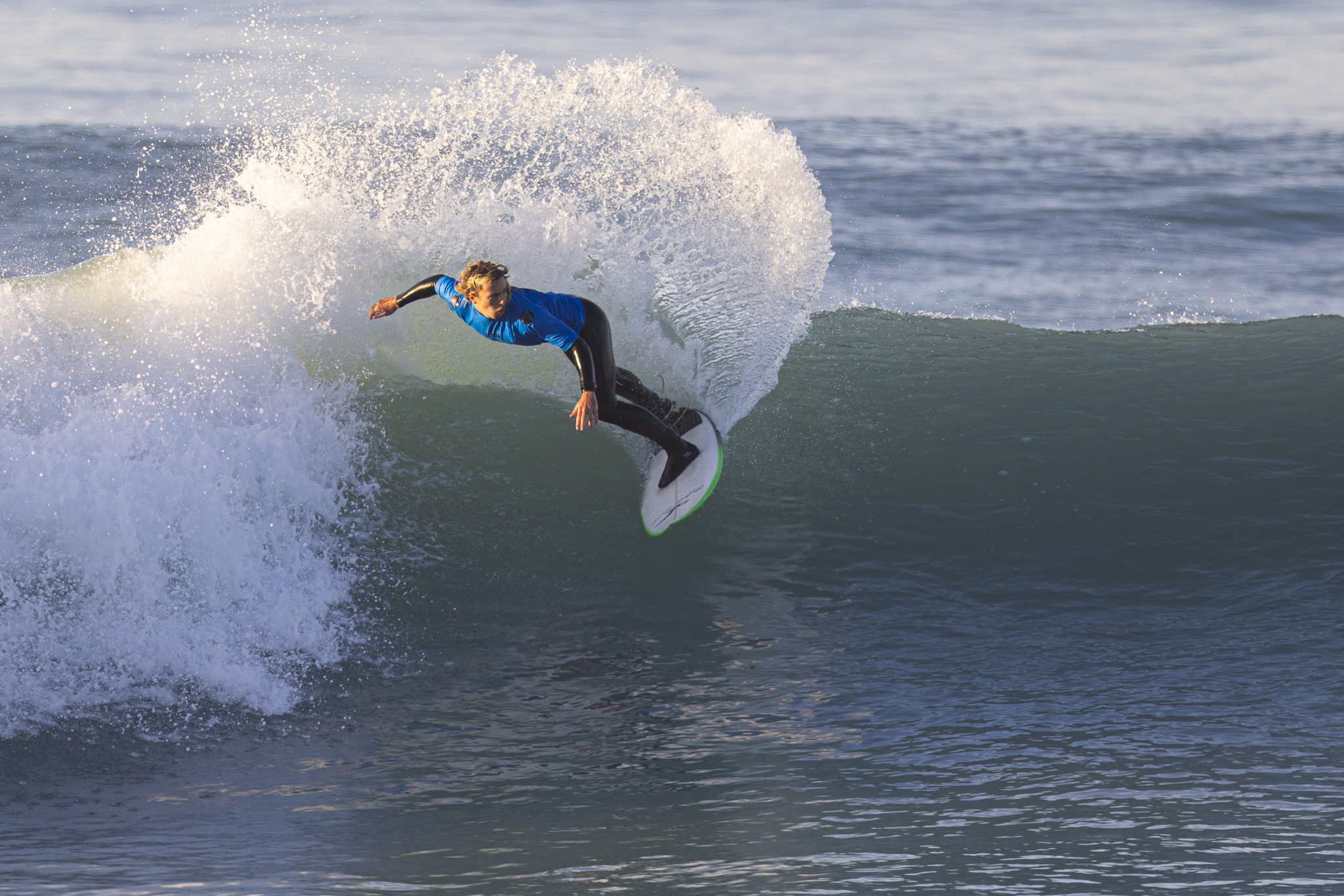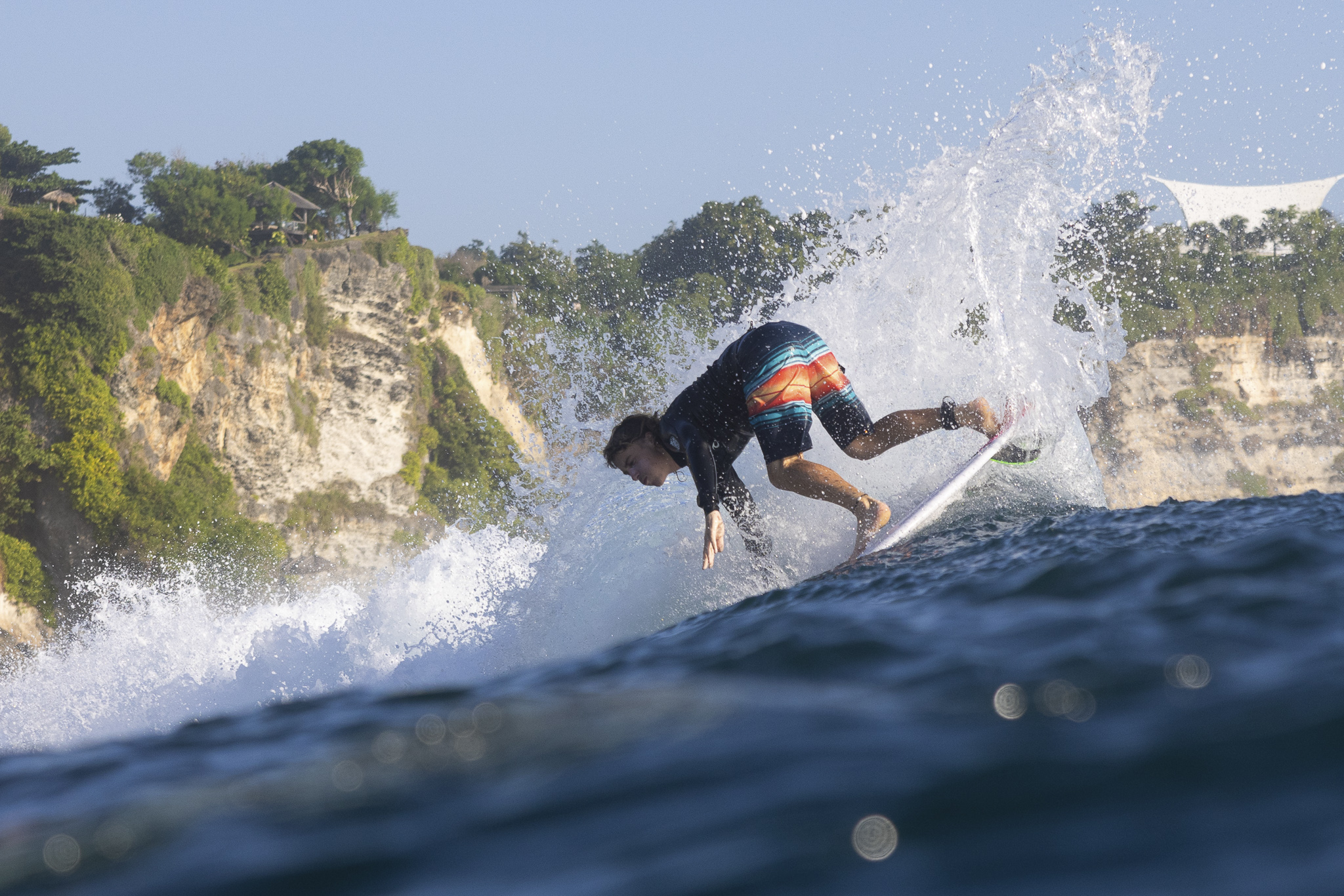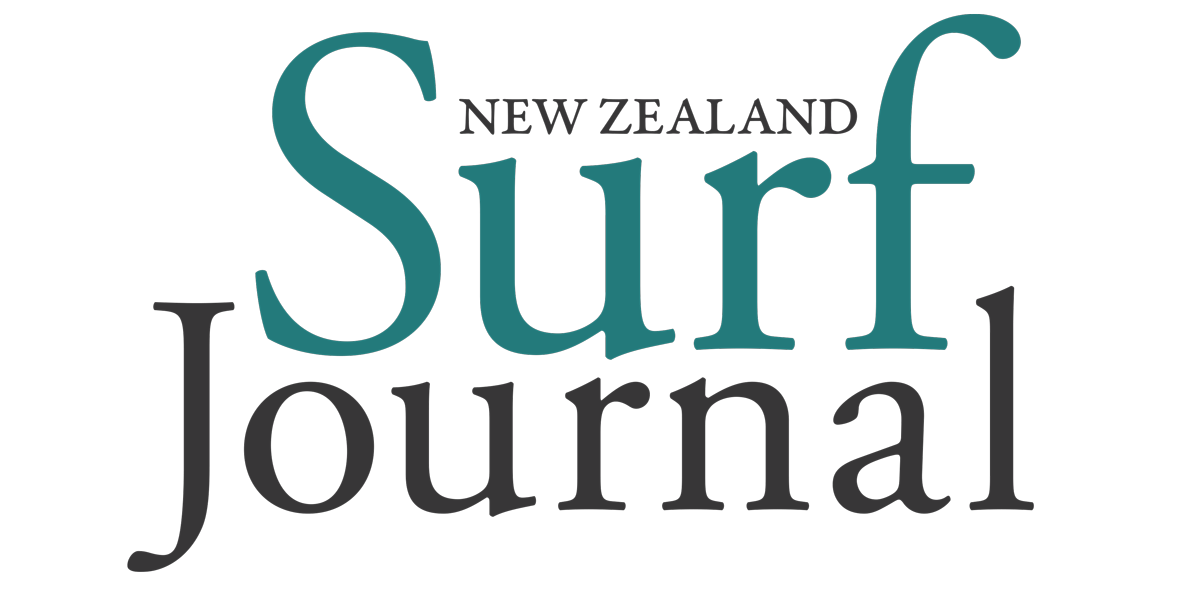George Roberts’ move to Australia to give the World Qualifying Series a crack in 2024 reveals just how brutal they can be, but also how those first round knockouts fuel his drive.

Surfing competitively in New Zealand is a pathway fraught with potholes. While the junior ranks are relatively well-catered to – especially in the South Island thanks to SISA’s grom series and grom inclusive events. But turn 18 and that pathway resembles more of a frayed cable, almost completely severed from the rest of the surfing world.
Surfers “aging out of the sport” at 18 is all too familiar. But for George Roberts, a second-generation competitive surfer, that wasn’t going to be an option.

At 18 he packed up and headed for the fertile surfing grounds of Australia’s East Coast with one intention: to crack the QS events that are held there between February and March each year. Despite a string of first round exits that brought him into a 105th place ranking, George believes he’s on the right track.
Now 19, George shares the high and lows from his year … and the many learning opportunities from that first rookie season.
“As soon as I could I went straight to Aussie,” he shares. “I was so scared. It was my first time living away from home. I thought if I wanted to do surfing as a pathway, I’d have to move over to Australia. The level of surfing is a lot higher – there are a lot more surfers and better surfers in Australia. That environment pushes you. It seems like the place you have to go if you want to become a professional surfer.”
“I was so scared. It was my first time living away from home. I thought if I wanted to do surfing as a pathway, I’d have to move over to Australia … It seems like the place you have to go if you want to become a professional surfer.”
Other Kiwis have used the Gold Coast hot bed and Tweed Heads as a landing pad, but George pushed a bit further south into the town of Coffs Harbour – roughly the midway point between Sydney and Brisbane.
“I have a couple mates there from Christchurch, and Benji Lowen, and his family, Kate and Johnny live there now, too.” George explains. “And then my mate, Niwa, who used to live in Christchurch, lives there as well. So there’s a good crew of Kiwis there. For the first month-and-a-half I stayed with Kate and Johnny, with Benji Lowen, who live right on the beach at Emerald. And then I moved into a flat with Niwa.”
Niwa manages the Cooper’s Surf Store in Coffs Harbour. While surfing is his focus, George also found work at the Coopers Surf Store, which is a chain of stores in New South Wales.

George said the Coffs Harbour Boardriders was really good and held about 10 comps a year. “They’re quite big contests with as many people as our Coldwater Classic comps. Each division has 16 to 20 surfers in it. “There are lots of good surfers in Coffs, so it’s good to push me.”
His daily routine is a familiar one.
“If I’m working all day, I’ll wake up, have a coffee or breakfast, and go surf from maybe 6:30am to 8am,” he admits. “After that I would go home and have some more food and then work 9am to 5:30pm. In the winter you can’t surf after work, so that’s why I go early. But then if I’m not working – I have a couple days each week where I don’t work – I’ll just wake up, surf, go home, have brekky, surf again – just surf all day.”
George reckons the work is easy – serving customers, selling them boards and wetsuits – and all within a 15-minute drive from Emerald Beach.
“This year was just to see what it’s like – just a learning year,” George continues. “I learnt a lot and I know what I’m in for next year, so that’s why I’ve just been trying to surf as much as possible and get as good as all those top guys.”
George said he had seen two sharks in the water since he arrived. “When I first moved over I was super scared, but then you just get used to it. One I saw was in a boardriders’ heat,” he laughs. “That was pretty scary. I saw it but I didn’t want to paddle in because everyone would’ve thought I was a pussy. So I just stayed out. It was in the final. I think it was just a bronzy.”
Another time he saw one at Emerald Beach. “There were a couple of us out there – it was quite big, and I decided to paddle away from everyone to try and get a good wave. All of a sudden I turned around and a big dorsal fin and tail fin went under the water. I just sat there and I thought I was going to die. I was like, I just have to stay calm. Then I imagined it coming and eating my arm off and I got scared and just bolted back to the crowd.”
“Someone told me that if they’re up above the water, they’re probably not going to get you. So I just waited for a good wave for five minutes and went in. It was scary.”
“I turned around and a big dorsal fin and tail fin went under the water. I just sat there and I thought I was going to die. I was like, I just have to stay calm. Then I imagined it coming and eating my arm off and I got scared and just bolted back to the crowd.”
Benji Lowen was out at Shelly Beach when a person was attacked not long after he moved there. “A lot of people were rattled when it first happened,” George offers. “But it’s such a good wave that you can’t really help but get back in. They’re mainly bull sharks and tiger sharks at Coffs. But there are some great whites … hopefully I don’t get bitten.”

I have to ask George if his ever-evolving dreaded mullet helped him fit into Aussie surf culture better. He laughs. “My dreads just formed over time. I forgot to buy shampoo for a week – I didn’t have my mum to pull my head in and tell me to shampoo my hair. I tried to condition and shampoo it, but they’re rock solid in there. Everyone thinks I’m an Aussie because I have the mullet, and then they hear my accent. They’re like, ‘oh, you’re a Kiwi’.”
“My dreads just formed over time. I forgot to buy shampoo for a week – I didn’t have my mum to pull my head in and tell me to shampoo my hair. I tried to condition and shampoo it, but they’re rock solid in there. Everyone thinks I’m an Aussie because I have the mullet, and then they hear my accent.”
The Gold Coast Open at Burleigh was George’s first baptism of fire in the world of QS competition. “I only got the call up for that first Burleigh comp the day before at three o’clock,” he shakes his head. “I was on the waiting list. Someone must have pulled out, and they’re like, ‘oh, are you in Australia? Do you want to come up and do the Burleigh comp?’. So, I just drove up. I’d never driven three hours away from anywhere by myself not knowing where to go.”
George made the trip and stayed with some friends. “I didn’t expect the wave to be that heavy,” he recalls. “I thought it was a longboard wave, but it was fully tubing and it was pretty gnarly.”
Heading straight into the Round of 80, George had little time to settle nerves. “I was really scared,” he admits. “Everyone was sponsored. They had stickers all over their boards, and I just came with my board with no stickers on it at all. When I was walking down everyone was looking at me really weird – they had probably never seen me before, I had no stickers on my board or anything. It was kind of cool being that guy – the different person.”
By the end of that first season George said he felt a lot more comfortable and knew most of the faces. But he admitted that it was quite a different environment compared with the more convivial New Zealand contests.
“I guess because they’re all on the same journey and trying to make a living out of it, they’re real focused,” George considers. “It’s not like New Zealand where everyone’s hanging out together. I like that about being back home. There are a couple of people like that over there who have obviously grown up in the sport since they were young, but a lot keep to themselves.”
He said it felt as though every surfer was as good as Caleb Cutmore or Billy Stairmand. “Every heat could be a New Zealand final – it’s pretty tough, but it’s good. It pushes you as a surfer.”

He said the level of intensity also spilled over to the teams they had around them. “They’ve got their coaches on the beach telling them to come in, or go out – every surfer has that support. There are coaches and filmers all over the beach – everyone had a coach and a filmer on the beach. I was hoping I’d get some clips, but they get paid by their surfer.”
George’s next contest took him to Port Stephens for the Port Stephens Pro where he’d start in the Round of 64. “That wave is super fun and that was a sick comp,” George recalls. “I did better there – I nearly got it – I needed a three.”
George said the scoring criteria in Australian QS events was quite different to here in New Zealand. “A three or a four over there would be more like a seven here,” he explains. “They score more on how critical the section was, how critical the turn was, how big the wave was. They want to see exciting stuff and they reward huge moments. They’re real fair though, the judges know if you got it or not – they don’t often under score or over score anyone.”
George admitted it was hard to find the big scores at times. “Now I know to hit the biggest sections and do the best I can.”

George’s third QS event, a QS 3000, took place at Avoca, on the Central Coast near Sydney – a five-hour drive from Coffs Harbour.
“I got up at two in the morning the day before the comp and drove down and decided I’d get a park early and surf early,” he recalls. “But everyone was already there. I needed to go a week earlier to get used to the break. Everyone had been there a week earlier.”
That extra time ahead of an event also adds cost with accommodation and time off work. “It’s a bit more expensive, but it’s going to be a benefit – you can get the feel of the wave and the area,” George concedes. “Avoca was a sick wave. It was big the first day, about five foot, but heaving – just full closeouts and throwing over. They put it on hold for a couple hours and then by 10am it was a bit smaller.”
George was well in the hunt in his Round of 128 at Avoca, only needing a four to progress. He stayed on after Avoca and drove to Newcastle – about an hour north of Avoca to prepare for the Burton Automotive Pro a QS5000 ranked event.
“I really liked Newcastle,” he adds. “There are lots of parks and it’s a sick wee wave with a great set up and heaps of good coffee and food.”
Again, George had comfortably eased into third in this Round of 128 heat, but needed a high four to progress.
The other Kiwis chasing the QS events included Caleb Cutmore, Billy Stairmand, Paige Hareb and Saffi Vette. They all chatted with George at some stage to offer advice. “Billy helped me out at Newcastle,” George shares. “He said he would come down and watch my heat. I was pretty stoked. And then I remember in that heat I thought that some other fulla had priority and I paddled down the beach to sit on him. And it turned out the guy that I was sitting on the entire time had the priority. I was in third and I was like, ‘oh shit’. And then they were all pointing for me to go back up, so I did. And then he snuck one just under me and got the score. I think he needed like a four and got it. It was a big learning curve – don’t be an idiot basically.”
“Billy helped me out at Newcastle. He said he would come down and watch my heat. I was pretty stoked. And then I remember in that heat I thought that some other fulla had priority and I paddled down the beach to sit on him. And it turned out the guy that I was sitting on the entire time had the priority. I was in third and I was like, ‘oh shit’. And then they were all pointing for me to go back up, so I did. And then he snuck one just under me and got the score. I think he needed like a four and got it. It was a big learning curve – don’t be an idiot basically.”
Despite the results, George knows he achieved what he came for – to get his feet in the wax in one of the biggest hotbeds of surfing in the world.

George said his QS campaign for 2024 cost him around $280 per comp plus insurance. He was living in Australia so qualified for the cheaper $25 insurance, which covered all four contests. Depending on where he stayed and where the event was held he’d pay up to $200 a night for accommodation, or stay with friends where he could, but would buy them groceries as a thank you. At one contest he stayed at the IBIS. “The IBIS was quite expensive though – probably $200 a night,” he recalls. “There was a French fulla staying there, too. He was in my heat as well, and he beat me.”

George’s advice to other New Zealand surfers dreaming of the big time, is to move across, even for the QS legs, and make it happen. “Obviously it’s going to be challenging – you’re leaving what you’re used to. It’s really difficult going to chase that – especially trying to catch a wave in a free surf with 128 of the best surfers in Australia, plus heaps of Japanese and Indonesian surfers as well. But it’s a good learning curve.”
George admitted that in many ways it will feel like you’re starting from scratch. “It felt like it did when I did my first ever South Island comp at Greymouth,” he smiles. “It felt exactly like that – I was nervous and didn’t really know anything about it. If you’re going to do them, go as a group and you’ll feel way less overwhelmed. You’ll worry more about the surfing instead of everything else like the travel and booking ahead etc. I was thinking about a lot and it was probably too much.”
“Obviously it’s going to be challenging – you’re leaving what you’re used to. It’s really difficult going to chase that – especially trying to catch a wave in a free surf with 128 of the best surfers in Australia, plus heaps of Japanese and Indonesian surfers as well. But it’s a good learning curve.”
George said he’d love to see a couple more younger people his age coming and doing them from New Zealand. “They’d probably like to see a Kiwi crew as well,” he reveals. “It’d be great to get more recognition for more New Zealand surfers and to see more New Zealanders doing it.”
Right now George is working hard and saving money so he can do it all again next year and he is also thinking about the Indonesian events next year. I ask him what he plans to differently in 2025.
“Every comp I lost, I felt real pumped – it felt like getting to a final back home every time. I was really driven as soon as I lost. Even at that first comp I was like, ‘fuck, I want to surf as good as all these guys because they’re so good’. That made me want to keep going.”
“I want to surf better next year,” he shares. “I want to have more heat strategy – just own it and try to do well. I want to do as well as I possibly can as a surfer. I’m pumped for it. Every comp I lost, I felt real pumped – it felt like getting to a final back home every time. I was really driven as soon as I lost. Even at that first comp I was like, ‘fuck, I want to surf as good as all these guys because they’re so good’. That made me want to keep going.”


